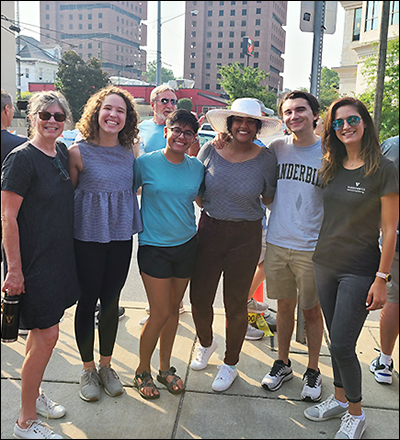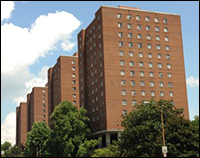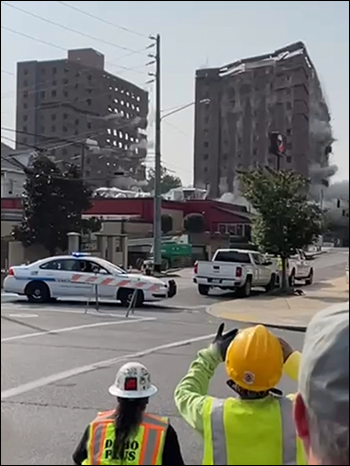
Four civil engineering students and their professor were guests of Layton Construction to view the July 31 mechanical demolition of Vanderbilt’s 14-story Carmichael Towers East residence halls from one of the company’s set locations.
The implosion process on Nashville’s West End Avenue was overseen by Layton Construction LLC and by Controlled Demolition Inc. (CDI), a national leader in large-structure controlled demolition. The east towers demolition had been delayed a year due to the COVID-19 pandemic. The west towers were demolished in July 2019 and new residential colleges have taken their place.
“The towers implosion viewing was a really special event and a unique leaning opportunity for our students. It lines up perfectly with Civil’s Introduction to Engineering module for first-year students where we discuss structures using reverse engineering,” said Ghina Absi, Ph.D.’2019, assistant professor of the practice of civil and environmental engineering whose research focuses on risk and reliability of structures. Absi also was a steel structures design engineer for almost five years in Beirut.

The ES 1400 module Absi will teach this fall includes exploring civil structures from the angle of controlled implosions. “It was a rare twin-implosion—the two towers were synchronized to fall a couple of seconds apart. Layton Construction invited us to their viewing gathering where we had a straight-shot view of the site,” she said. Graduate student Caroline Janssen, BE’20; and seniors Sofia Ramirez Starkey, Kristi Maisha and Michael Roman, all with interests in structural engineering, joined Absi and Lori Troxel, director of undergraduate studies and professor of the practice of civil and environmental engineering.
“This was an exhilarating experience, both engineering-wise and emotional-wise. These towers have been a part of the face of Vanderbilt for a long time, and it was bittersweet to see them go,” Absi said. “We are thankful for Layton Construction’s accommodation and for the CEE department and the Dean of Students’ offices for their support and help in organizing this opportunity.”

The Carmichael Towers East’s last residents moved out at the end of the spring 2021 semester, and Residential College C will be built in its place, with a scheduled opening in fall 2024. It will be the fourth residential college along West End Avenue. The demolition of west towers made way for the opening of Nicholas S. Zeppos College in August 2020. The E. Bronson Ingram College opened in 2018, and Rothschild College will open for fall 2022.
The Carmichael towers housed undergraduate students and were named in memory of the university’s third chancellor, Oliver Cromwell Carmichael. The east towers were completed in 1966, and the west towers in 1970.

“The implosion happened so quickly—in fewer than 10 seconds. I’ve rewatched the video I took so many times, and I’m just amazed that I could watch that happen live,” said Kristi Maisha. “The two towers really went down at almost the same time, and, from what I saw and heard, everything was very successful. It’s really a testament to the teams that planned the implosion process and prepared the buildings–reducing two 14-story buildings to rubble so efficiently and safely.”
Maisha’s research mentor is a 2000 Vanderbilt graduate who lived in tower 1. “It was nice to hear about her experiences there. Those 4 boxes had housed so many students for decades. So many stories, so much personal growth,” she said. “Just the sheer number of students who passed through those doors is kind of crazy to think about. But it’s also exciting because the new residential colleges will stand for decades and shape so many new Vanderbilt students’ lives.”
Michael Roman found it awe-inspiring. “It was incredible to witness the civil engineering profession in action on Vanderbilt’s campus and on such a large scale. It was impressive,” he said.

It was bittersweet moment for Sofia Ramirez Starkey. “I lived in Tower 1 during my sophomore year when living on campus was cut short by COVID. I have so many memories tied to that place, and I know there are many more generations of students who also have their own memories. However, I’m excited for the new buildings that are being built in their place and to see how much the campus will be transformed just within a few years.”
The design for all residential colleges between 23rd and 24th avenues gives the area a more park-like feel. The university has redeveloped the area to add green space, pedestrian- and bike-friendly pathways and tiered areas for studying, relaxing and hosting outdoor gatherings, and aligns with a key pillar of Vanderbilt’s Academic Strategic Plan, which is to strengthen the undergraduate residential experience.
Contact: Brenda Ellis, 615 343-6314
brenda.ellis@vanderbilt.edu